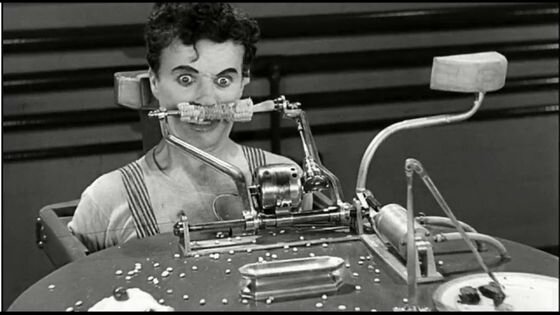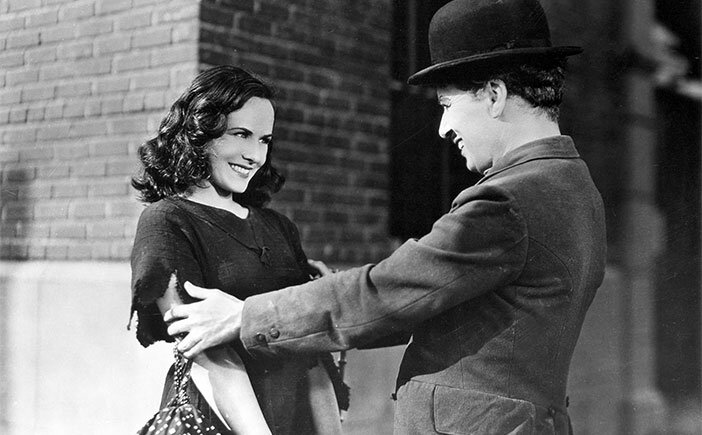Modern Times (1936)
Written & Directed by Charlie Chaplin
1998 List Ranking: 81
2007 List Ranking: 78
As this list goes on, I am becoming an ever-increasing fan of Charlie Chaplin. While his previous film on this list, City Lights, didn’t quite measure up to the brilliance of The Gold Rush, Modern Times reaches that greatness and becomes a fantastic and rather emotional send-off to Chaplin’s Tramp character.
The Tramp vs. the feeding machine
As physical as ever, Chaplin shows off exactly why I enjoy physical comedy more than the Marx Brothers’ brand of verbal comedy. Nearly from the start, Chaplin is in excellent form as he battles with machinery in the factory in which he is employed, starting with a sequence that clearly inspires the classic I Love Lucy chocolate conveyer belt routine. More hilarious than that is Chaplin’s experience being strapped into a feeding machine that, as expected, goes haywire. It’s interesting that the film before this, A Night at the Opera, elicited perhaps one small chuckle during its 90 minutes, while Modern Times had me bark-laughing less than 10 minutes into it.
The gears
The initial factory sequence also provides an iconic shot in film history, in which Chaplin falls into a machine and we see him traverse a course around the various gears inside it. It’s pretty short, but it’s a shot that’s been emulated quite often (although, admittedly, an example escapes my memory at the moment).
I will say that there are some things that don’t quite make sense. First is the decision to have a film that weirdly straddles being both a talkie and a silent film: there’s title cards and silent moments, but also a synchronized score, sound effects, and some actual dialogue. I completely understand the decision to not have the Tramp talk, because I agree with Chaplin that the Tramp would lose his appeal if he could talk, but if you’re going to make a silent film then make a silent film. It almost feels like time and culture is literally pulling this film forward in history, and it does create a bit of a disjointed effect.
The least-homeless-looking homeless woman I’ve ever seen
Also, the decision to have Paulette Goddard as Ellen, a poor (and eventually homeless) young woman, look stunningly gorgeous is strange. Aside from being barefoot and having an artistic dirt smudge on her cheek, she doesn’t look believable for the situation she’s in. Also, she has two sisters who are taken to the orphanage, and we never see or hear from them again. Seriously, she escapes the police officer who is taking them to the orphanage, and she never does anything about them, not even mentioning them. WHAT ABOUT THE SISTERS??
Finally, I was surprised by (and, admittedly, laughed at) the minor plot point of “nose-powder” (AKA cocaine). Seeing Chaplin accidentally ingest it and begin tripping was funny, but also the fact that it had to be called “nose-powder” will never not crack me up. I’ve said it before, but read up on the Hays Code of this era to see what ridiculous restrictions filmmakers had on their content.
Chaplin performing “The Nonsense Song”
As I mentioned, this film is the send off of Chaplin’s Tramp character (although he plays a different-but-similarly-looking character in The Great Dictator). I happened to know this before seeing this film, so I will admit that this knowledge did effect how I saw the film, particularly the final sequences. Over the course of Chaplin’s three films on this list, I have become entranced with the Tramp, so seeing the film winding down and knowing that the character was almost over was actually somewhat emotional. I mentioned that Chaplin was opposed to having the Tramp speak, so it was a delight when the Tramp, near the end of the film, sings a song in gibberish French and Italian. There was something…bittersweet about the scene, as delightful as it was. It feels as if the talkies “won”, forcing Chaplin to abandon this popular character due to the change in the medium. I don’t know how true that feeling is (perhaps Chaplin was over the character anyway), but it does feel like the end of an era.
Farewell…
More emotional than finally hearing the Tramp’s voice is the final scene, which sees him doing his distinctive waddle off into sunrise. It’s strange, I admit, to feel so emotional about a character that, a few weeks ago, I knew only by pictures, but such is the depth of Chaplin’s brilliance and creativity. He created a character that people instantly connect with and that has ultimately out-lived and transcended him. The Tramp may have walked away, but thanks to things like this list, he’s never really gone.
FINAL GRADE: A-







